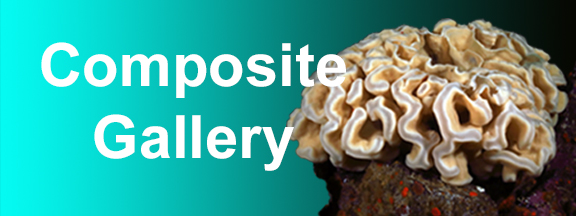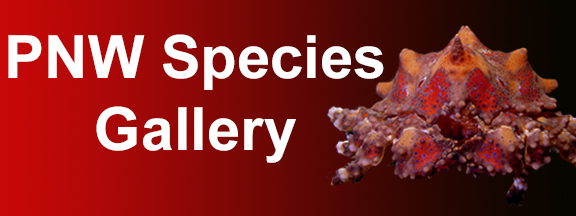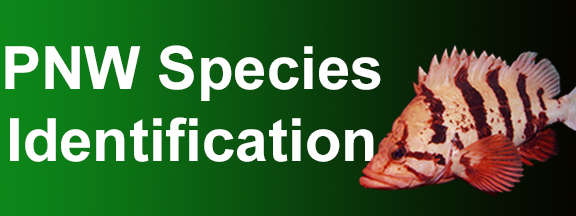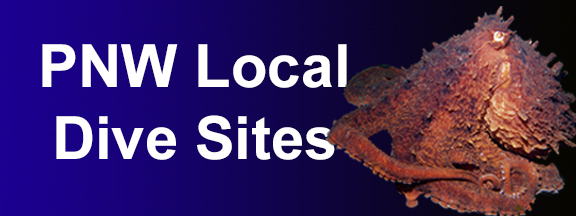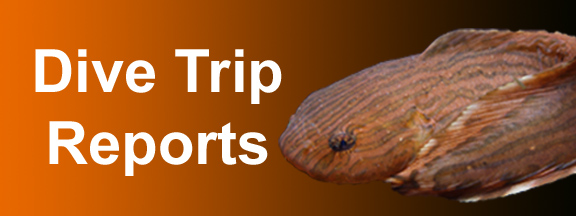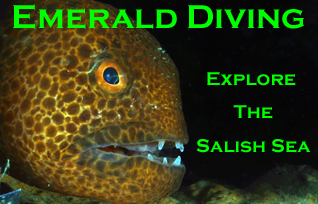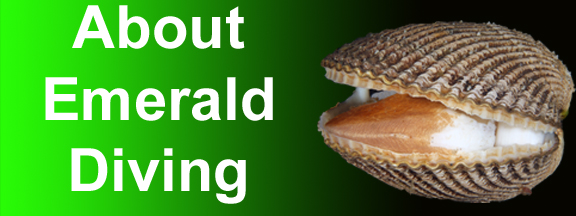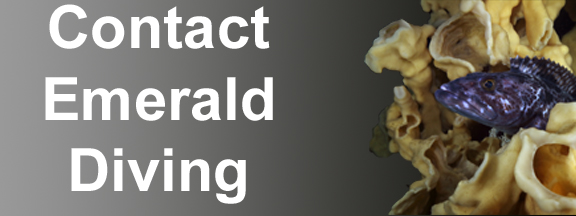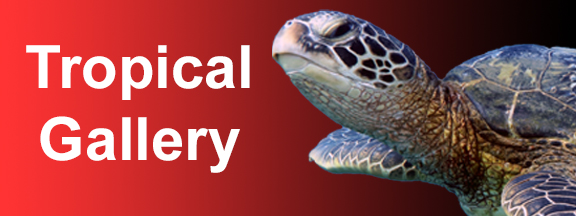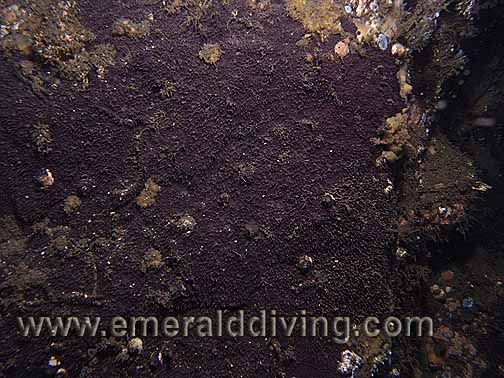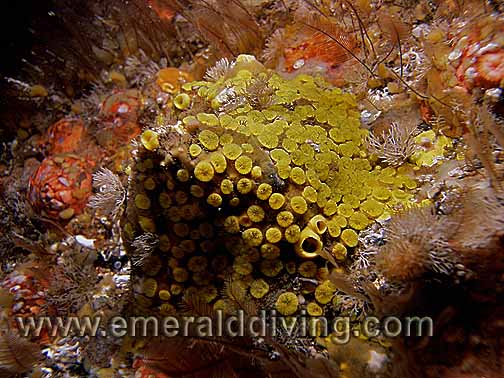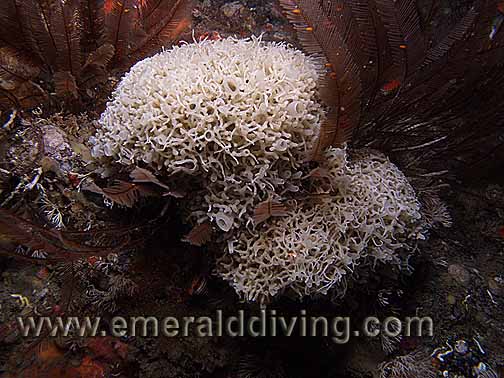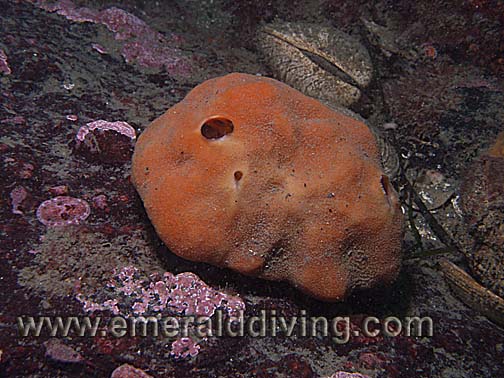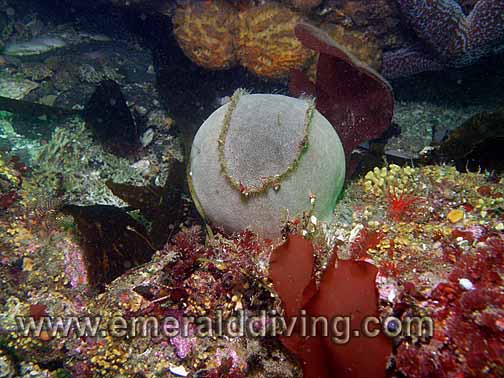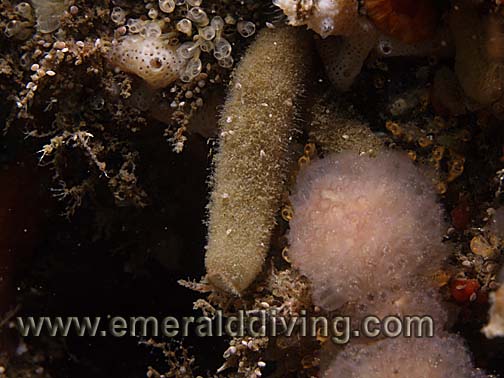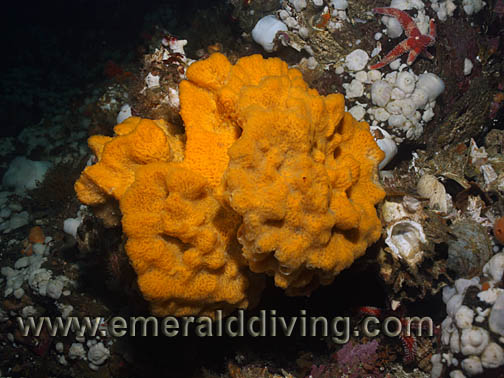

The enlargement viewer only works properly once ALL images on this page are loaded.
Aggregated Nipple Sponge
Polymastia pachymastia
Typical size: 1-3 height
ID: Grayish mat with multiple yellow cone-shaped protrusions.
Comments: I frequently noted this unique sponge in the Cape Flattery area and parts of the San Juan Islands. The number of cones per colony can very greatly. Pictured is a rather large aggregate vase sponge that I found in the Cape Flattery area. This species is also referred to as an aggregate vase sponge.
Polymastia pachymastia
Typical size: 1-3 height
ID: Grayish mat with multiple yellow cone-shaped protrusions.
Comments: I frequently noted this unique sponge in the Cape Flattery area and parts of the San Juan Islands. The number of cones per colony can very greatly. Pictured is a rather large aggregate vase sponge that I found in the Cape Flattery area. This species is also referred to as an aggregate vase sponge.
Retractable Nipple Sponge
Weberella sp.
Typical size: 1 thick
ID: Varies, but typically yellow with numerous, low volcano-like nipples.
Comments: The fairly common sponge often collects debris and has a somewhat dirty appearance. Blakely Rock has several healthy colonies of this sponges. AS teh name implies the nipples on this sponge can retract.
Weberella sp.
Typical size: 1 thick
ID: Varies, but typically yellow with numerous, low volcano-like nipples.
Comments: The fairly common sponge often collects debris and has a somewhat dirty appearance. Blakely Rock has several healthy colonies of this sponges. AS teh name implies the nipples on this sponge can retract.
Cloud Sponge
Aphrocallistes vastus
Typical size: 1-10 diameter
ID: Large uneven rounded tubular branches. Color varies from white to yellow to orange.
Comments: The magnificent cloud sponge often prefers deeper waters than recreational scuba limits. However, a healthy field of sponges reside in 90 feet of water at Gedney Bar. Less healthy specimens area readily found at certain sites in Hood Canal. This 6' specimen was photographed in Esperanze Inlet at gorgeous Tahsis Narrows in British Columbia in 105 feet of water'.
Aphrocallistes vastus
Typical size: 1-10 diameter
ID: Large uneven rounded tubular branches. Color varies from white to yellow to orange.
Comments: The magnificent cloud sponge often prefers deeper waters than recreational scuba limits. However, a healthy field of sponges reside in 90 feet of water at Gedney Bar. Less healthy specimens area readily found at certain sites in Hood Canal. This 6' specimen was photographed in Esperanze Inlet at gorgeous Tahsis Narrows in British Columbia in 105 feet of water'.
Deadman Finger Sponge
Neoesperiopsis digitata
Typical size: 12-24 height
ID: Long and thick brown to tan colored fingers.
Comments: I only note this hearty sponge in the Cape Flattery area in areas of high current. Duncan Rock offers excellent opportunities to view this sponge. Many of hte walls in Browning Pass in the Port hardy areas are covered with tdeadman finger sponges.
Neoesperiopsis digitata
Typical size: 12-24 height
ID: Long and thick brown to tan colored fingers.
Comments: I only note this hearty sponge in the Cape Flattery area in areas of high current. Duncan Rock offers excellent opportunities to view this sponge. Many of hte walls in Browning Pass in the Port hardy areas are covered with tdeadman finger sponges.
Glove Sponge
Neoesperiopsis digitata
Typical size: 8-12 height
ID: Light yellow color with rounded tubes.
Comments: This sponge looks like a cross between a deadmans finger sponge and an orange tube sponge. Noted in abundance in the heavy current at Shark Reef in San Juan Channel, which is where this photo was taken. The sponge is sitting sidways due to the heavy current. Thanks to Andy Lamb for identifiyting this species.
Neoesperiopsis digitata
Typical size: 8-12 height
ID: Light yellow color with rounded tubes.
Comments: This sponge looks like a cross between a deadmans finger sponge and an orange tube sponge. Noted in abundance in the heavy current at Shark Reef in San Juan Channel, which is where this photo was taken. The sponge is sitting sidways due to the heavy current. Thanks to Andy Lamb for identifiyting this species.
Orange Finger Sponge
Neoesperiopsis rigida
Typical size: 6-12 height
ID: Multiple, thick orange branches emanating from a single base.
Comments: I only note this spectacular sponge attched to current strickened reefs in the Cape Flattery area. Note the water is blue in the background, which occasionally happens around Cape Flattery.
Neoesperiopsis rigida
Typical size: 6-12 height
ID: Multiple, thick orange branches emanating from a single base.
Comments: I only note this spectacular sponge attched to current strickened reefs in the Cape Flattery area. Note the water is blue in the background, which occasionally happens around Cape Flattery.
Orange Ball Sponge
Tethya californiana
Typical size: 2-8 diameter
ID: Orange/yellow ball shape with broken brown crust. Usually grows in small clusters.
Comments: These cool looking sponges look like they just popped out of a volcano. This species is commonplace on Cape Flattery reefs. I sometimes note these sponges when diving the San Juan Islands. I ususally find these sponges in cluster of balls of various sizes, as pictured here.
Tethya californiana
Typical size: 2-8 diameter
ID: Orange/yellow ball shape with broken brown crust. Usually grows in small clusters.
Comments: These cool looking sponges look like they just popped out of a volcano. This species is commonplace on Cape Flattery reefs. I sometimes note these sponges when diving the San Juan Islands. I ususally find these sponges in cluster of balls of various sizes, as pictured here.
Purple Encrusting Sponge
Typical size: <1 height
ID: Distinctive purple color, can cover several square feet of area.
Comments: I only occasionally note this low-profile and unspectacular sponge. However, I am certain it is fairly common - I just don't look for it.
Typical size: <1 height
ID: Distinctive purple color, can cover several square feet of area.
Comments: I only occasionally note this low-profile and unspectacular sponge. However, I am certain it is fairly common - I just don't look for it.
Rough Scallop Sponge
Myxilla incrustans
Typical size: 1/2 thick
ID: Yellow/orange encrusting sponge that covers the entire top of the scallop. Numerous high- rising volcano like mounds with pores.
Comments: This sponge is very common anywhere scallops are present. The wall along the west side of Strawberry Island is covered with scallops encrusted with this sponge.
Myxilla incrustans
Typical size: 1/2 thick
ID: Yellow/orange encrusting sponge that covers the entire top of the scallop. Numerous high- rising volcano like mounds with pores.
Comments: This sponge is very common anywhere scallops are present. The wall along the west side of Strawberry Island is covered with scallops encrusted with this sponge.
Smooth Scallop Sponge
Mycale adhaerens
Typical size: 1/4 thick
ID: Yellow or purple encrusting sponge on top of scallop shell. Typically covers the entire shell.
Comments: This sponge is also very common anywhere scallops are present. The wall along the west side of Strawberry Island is covered with scallops encrusted with this sponge.
Mycale adhaerens
Typical size: 1/4 thick
ID: Yellow or purple encrusting sponge on top of scallop shell. Typically covers the entire shell.
Comments: This sponge is also very common anywhere scallops are present. The wall along the west side of Strawberry Island is covered with scallops encrusted with this sponge.
Trumpet Sponge
Stylissa stipitata
Typical size: 6-12 height
ID: Unique yellow funnel shaped sponge.
Comments: The trumpet sponge lacks the folds of the funnel sponge. I almost exclusively find this odd-looking sponge in the Cape Flattery area. This picture was taken while diving off the south side of Tatoosh Island.
Stylissa stipitata
Typical size: 6-12 height
ID: Unique yellow funnel shaped sponge.
Comments: The trumpet sponge lacks the folds of the funnel sponge. I almost exclusively find this odd-looking sponge in the Cape Flattery area. This picture was taken while diving off the south side of Tatoosh Island.
Yellow Boring Sponge
Cliona celata
Typical size: 1/4 - 1/2 diameter protrusions.
ID: Yellow round protrusions clustered together to form patches of variable size.
Comments: I often note colonies of this small, flat sponge encrusting rocks in current swept areas. This sponge seems to do well in most Washington waters.
Cliona celata
Typical size: 1/4 - 1/2 diameter protrusions.
ID: Yellow round protrusions clustered together to form patches of variable size.
Comments: I often note colonies of this small, flat sponge encrusting rocks in current swept areas. This sponge seems to do well in most Washington waters.
Yellow Encrusting Sponge
Myxilla lacunosa
Typical size: Variable size, often 12 or more (diameter).
ID: Yellow, often with brown patches. Shallow channels and holes throughout surface.
Comments: This sponge can grow quite large. I often noted the yellow ecnrusting sponge in the Cape Flattery area and San Juan Islands on current swept rocky reefs. Also referred to as a sulfur sponge.
Myxilla lacunosa
Typical size: Variable size, often 12 or more (diameter).
ID: Yellow, often with brown patches. Shallow channels and holes throughout surface.
Comments: This sponge can grow quite large. I often noted the yellow ecnrusting sponge in the Cape Flattery area and San Juan Islands on current swept rocky reefs. Also referred to as a sulfur sponge.
Yellow Branching Sponge
Syringella amphispicula
Typical size: 4-12 height
ID: Yellow twig-like branches.
Comments: Like many invertebrate, I note smaller and less robust looking specimens of this sponge in Puget Sound. Larger yellow branching sponges are found in the San Juan Islands and Cape Flattery area. This sponge often has a "dirty" appearance. Branch thickness varies, as does the shade of yellow.
Syringella amphispicula
Typical size: 4-12 height
ID: Yellow twig-like branches.
Comments: Like many invertebrate, I note smaller and less robust looking specimens of this sponge in Puget Sound. Larger yellow branching sponges are found in the San Juan Islands and Cape Flattery area. This sponge often has a "dirty" appearance. Branch thickness varies, as does the shade of yellow.
White Sponge
Adocia sp.
Typical size: 8-14 diameter
ID: White or off-white. Large holes are typically located on protruding chimneys.
Comments: I often note this sponge in the Cape Flattery area and San Juan Islands on current swept rocky reefs. I rarelynote it elsewhere. It can grow quite large.
Adocia sp.
Typical size: 8-14 diameter
ID: White or off-white. Large holes are typically located on protruding chimneys.
Comments: I often note this sponge in the Cape Flattery area and San Juan Islands on current swept rocky reefs. I rarelynote it elsewhere. It can grow quite large.
Tube Ball Sponge
Leucosolenia eleanor
Typical size: 2-5 diameter
ID: Web of intricate, small tubes that form a clump or ball. White color.
Comments: I only note this delicate looking sponge when diving the San Juan Islands and Cape Flattery area.
Leucosolenia eleanor
Typical size: 2-5 diameter
ID: Web of intricate, small tubes that form a clump or ball. White color.
Comments: I only note this delicate looking sponge when diving the San Juan Islands and Cape Flattery area.
Orange Cratered Encrusting Sponge
Hamegera sp.
Typical size: 4-6 diameter
ID: Orange sponge covered in small craters and pores.
Comments: I n over 1000 Northwest dives, I had never noted this small inconspicuous sponge. Now that I know what it is, I often find it on current swept reefs in Puget Sound. This sponge flourishes at Possession Point Fingers, which is where this photo was taken.
Hamegera sp.
Typical size: 4-6 diameter
ID: Orange sponge covered in small craters and pores.
Comments: I n over 1000 Northwest dives, I had never noted this small inconspicuous sponge. Now that I know what it is, I often find it on current swept reefs in Puget Sound. This sponge flourishes at Possession Point Fingers, which is where this photo was taken.
Peach Ball Sponge
Suberites montiniger
Typical size: 4-8 diameter
ID: Rounded shape with several large, prominent pores. Shape and size varies, but color is usually orange.
Comments: I often note this species of sponge when diving the San Juan Islands. This picture was taken at a dive site on the south end of lopez Island near Iceberg Point in 80 fsw. About a dozen of these sponges inhabited a relatively small area.
Suberites montiniger
Typical size: 4-8 diameter
ID: Rounded shape with several large, prominent pores. Shape and size varies, but color is usually orange.
Comments: I often note this species of sponge when diving the San Juan Islands. This picture was taken at a dive site on the south end of lopez Island near Iceberg Point in 80 fsw. About a dozen of these sponges inhabited a relatively small area.
Grey Puffball Sponge
Craniella villosa
Typical size: 4-8 diameter
ID: Smooth round shape, gray.
Comments: Tell me this isn't an octpus's bowling ball! This amazing sponge is fairly common in the Cape Flattery area. Waadah Island Fingers, which is where this photo was taken, is one of the best dive sites to find this sponge.
Craniella villosa
Typical size: 4-8 diameter
ID: Smooth round shape, gray.
Comments: Tell me this isn't an octpus's bowling ball! This amazing sponge is fairly common in the Cape Flattery area. Waadah Island Fingers, which is where this photo was taken, is one of the best dive sites to find this sponge.
Spiny Tennis Ball Sponge
Craniella spinose
Typical size: 2-4 diameter
ID: Whitish coloration with thin, protruding spinicules.
Comments: I have only noted this unique sponge will diving the area around Tumbo Island, which is where this imae was taken.
Craniella spinose
Typical size: 2-4 diameter
ID: Whitish coloration with thin, protruding spinicules.
Comments: I have only noted this unique sponge will diving the area around Tumbo Island, which is where this imae was taken.
Pale Orange Carpet Sponge
Adocia sp.
Typical size: 0.5 height,
ID: Sprawling, low profile pale orange sponge with numerous small round mounds.
Comments: I often note this sponge on rocky reefs throughout the San Juan Islands. This sponge can span several square feet. This photo was taken at Lawson Bluff on Sucia Island.
Adocia sp.
Typical size: 0.5 height,
ID: Sprawling, low profile pale orange sponge with numerous small round mounds.
Comments: I often note this sponge on rocky reefs throughout the San Juan Islands. This sponge can span several square feet. This photo was taken at Lawson Bluff on Sucia Island.
Funnel Sponge
Phakellia sp.
Typical size: 6-12 height
ID: Unique yellow funnel shaped sponge with folds.
Comments: I almost exclusively find this odd-looking sponge in the San Juan Islands and Cape Flattery area. This picture was taken at Long Island in the San Juan Islands. Note the field of strawberry anemones in the background.
Phakellia sp.
Typical size: 6-12 height
ID: Unique yellow funnel shaped sponge with folds.
Comments: I almost exclusively find this odd-looking sponge in the San Juan Islands and Cape Flattery area. This picture was taken at Long Island in the San Juan Islands. Note the field of strawberry anemones in the background.
Red-Brown Encrusting Sponge
Typical size: 1-4 height
ID: Brown/red color with numerous small pores with occasional larger pores
Comments: I only note this sponge when dive high-current and exposed areas in the Cape Flattery area. Most of the dives around the west and south side of Tatoosh Island will produce red-brown sponge sightings.
Typical size: 1-4 height
ID: Brown/red color with numerous small pores with occasional larger pores
Comments: I only note this sponge when dive high-current and exposed areas in the Cape Flattery area. Most of the dives around the west and south side of Tatoosh Island will produce red-brown sponge sightings.
Tubular Vase Sponge
Scypha compacta
Typical size: 2-4 length
ID: Cylindrical shape with tiny opening at un-anchored end. Covered in tiny bristles.
Comments: This sponge is very small and not overly flamboyant. I have only noted it in the Cape Flattery area, but may have simply overlooked it in other regions.
Scypha compacta
Typical size: 2-4 length
ID: Cylindrical shape with tiny opening at un-anchored end. Covered in tiny bristles.
Comments: This sponge is very small and not overly flamboyant. I have only noted it in the Cape Flattery area, but may have simply overlooked it in other regions.
Aggregated Vase Sponge
Polymastia pacifica
Typical size: 0.5 height
ID: Narrow and small pores. Mat is often dominated covered by silt and indistinguishable.
Comments: This sponge runs rampant over many parts of silty Hood Canal. However, dues to it small size it is easily overlooked. Large sections around Flagpole Point are home to this sponge, which is where this photo was taken.
Polymastia pacifica
Typical size: 0.5 height
ID: Narrow and small pores. Mat is often dominated covered by silt and indistinguishable.
Comments: This sponge runs rampant over many parts of silty Hood Canal. However, dues to it small size it is easily overlooked. Large sections around Flagpole Point are home to this sponge, which is where this photo was taken.
Sharped Lipped Boot Sponge
Rhabdocalyptus dawsoni
Typical size: 2-4' height
ID: Tall tubular sponge, always heavily silted. White interior does NOT extend over the lip of the opening.
Comments: I typically note this sponge in the San Juans and Gulf Islands at depths of greater than 80 feet.
This sponge often serves as a host to many other creatures. Note the white egg nudibranch egg cluster attached to the right of this sponge. This sponge was photographed in Tahsis Narrows in British Columbia against a backdrop of strawberry anemones.
Rhabdocalyptus dawsoni
Typical size: 2-4' height
ID: Tall tubular sponge, always heavily silted. White interior does NOT extend over the lip of the opening.
Comments: I typically note this sponge in the San Juans and Gulf Islands at depths of greater than 80 feet.
This sponge often serves as a host to many other creatures. Note the white egg nudibranch egg cluster attached to the right of this sponge. This sponge was photographed in Tahsis Narrows in British Columbia against a backdrop of strawberry anemones.
Iophon Sponge
Typical size: 8-12 diameter
ID: Shallow branches, yellow to pale yellow in coloration.
Comments: I only note this variety of sponge in the Neah Bay area and British Columbia. The specimen in this photograph is silhouetted against a field of strawberry anemones in Tahsis Narrows in British Columbia.
Typical size: 8-12 diameter
ID: Shallow branches, yellow to pale yellow in coloration.
Comments: I only note this variety of sponge in the Neah Bay area and British Columbia. The specimen in this photograph is silhouetted against a field of strawberry anemones in Tahsis Narrows in British Columbia.
Thick Strap Sponge
Pachchalina spp.
Typical size: Varies greatly
ID: Whiteish pink color with obvious exhaust vent at the end of each finger.
Comments: I have only noted this sponge at Race Rocks, although I am certain is persists in many other area. Photographed at Race Rocks West Wall.
Pachchalina spp.
Typical size: Varies greatly
ID: Whiteish pink color with obvious exhaust vent at the end of each finger.
Comments: I have only noted this sponge at Race Rocks, although I am certain is persists in many other area. Photographed at Race Rocks West Wall.
Breast Sponge
Eumastia sitiens, Halichondria sitiens, Pellina sitiens
Typical size: 6 height
ID: Compact sponge with thin branching arms. Colors vary.
Comments: This is yet another of many sponges that we just don't know much about. Many biologists seem to have left field research behind in pursuit of work that pays much better. Photographed at Tumbo Island wall in the Gulf Islands.
Eumastia sitiens, Halichondria sitiens, Pellina sitiens
Typical size: 6 height
ID: Compact sponge with thin branching arms. Colors vary.
Comments: This is yet another of many sponges that we just don't know much about. Many biologists seem to have left field research behind in pursuit of work that pays much better. Photographed at Tumbo Island wall in the Gulf Islands.
Hard Gnarled Clump Sponge
Xestopongia hispida
Typical size: varies greatly
ID: Orange-yellow to off-white color with hard crust. Irregular mound shapes.
Comments: I find this sponge in high current areas, including the Port Hardy and Neah Bay areas. Photograph taken in Browning Pass, British Columbia.
Xestopongia hispida
Typical size: varies greatly
ID: Orange-yellow to off-white color with hard crust. Irregular mound shapes.
Comments: I find this sponge in high current areas, including the Port Hardy and Neah Bay areas. Photograph taken in Browning Pass, British Columbia.
Red Volcano Sponge
Acarnus erithacus
Typical size: Varies greatly on size.
ID: Low-profile sprawling sponge, orange-red in color.
Comments: This low-profile sponge prefers current swept area and will form bumpy mats. This sponge is covering giant barnacle shells in this photograph. Photgraphed in Browning Pass in British Columbia. Also referred to as thick encrusting scarlet sponge.
Acarnus erithacus
Typical size: Varies greatly on size.
ID: Low-profile sprawling sponge, orange-red in color.
Comments: This low-profile sponge prefers current swept area and will form bumpy mats. This sponge is covering giant barnacle shells in this photograph. Photgraphed in Browning Pass in British Columbia. Also referred to as thick encrusting scarlet sponge.
Stalked Vase Sponge
Leucilla nuttingi
Typical size: 1-2 height
ID: Small vase-like sponges on short stalks (hidden in this photo).
Comments: These subtle little sponges stand no more than 2" tall and are somewhat abundant in 35-50 fsw at Possession Point Fingers. They seem to grow in small colonies ranging from 10 to as few as 2 vases.
Leucilla nuttingi
Typical size: 1-2 height
ID: Small vase-like sponges on short stalks (hidden in this photo).
Comments: These subtle little sponges stand no more than 2" tall and are somewhat abundant in 35-50 fsw at Possession Point Fingers. They seem to grow in small colonies ranging from 10 to as few as 2 vases.


